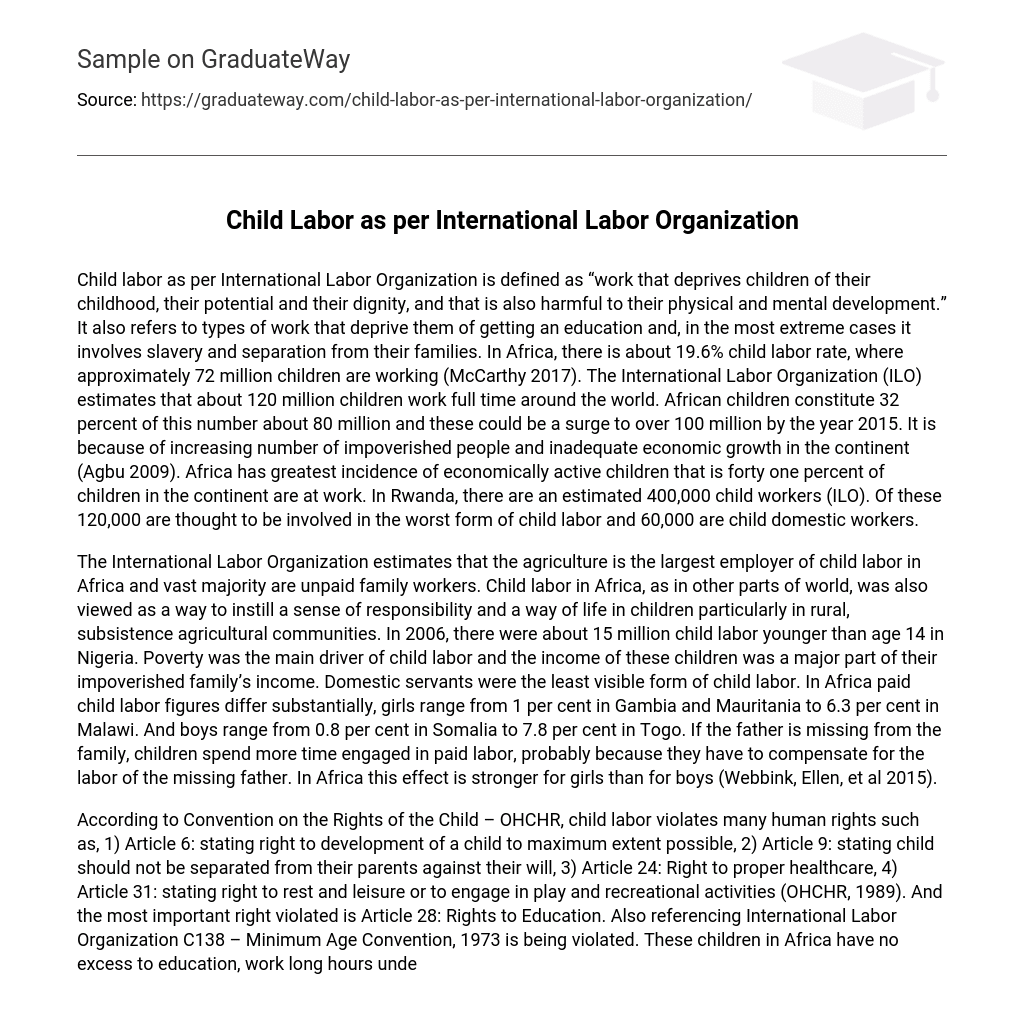Child labor as per International Labor Organization is defined as “work that deprives children of their childhood, their potential and their dignity, and that is also harmful to their physical and mental development.” It also refers to types of work that deprive them of getting an education and, in the most extreme cases it involves slavery and separation from their families. In Africa, there is about 19.6% child labor rate, where approximately 72 million children are working (McCarthy 2017). The International Labor Organization (ILO) estimates that about 120 million children work full time around the world. African children constitute 32 percent of this number about 80 million and these could be a surge to over 100 million by the year 2015. It is because of increasing number of impoverished people and inadequate economic growth in the continent (Agbu 2009). Africa has greatest incidence of economically active children that is forty one percent of children in the continent are at work. In Rwanda, there are an estimated 400,000 child workers (ILO). Of these 120,000 are thought to be involved in the worst form of child labor and 60,000 are child domestic workers.
The International Labor Organization estimates that the agriculture is the largest employer of child labor in Africa and vast majority are unpaid family workers. Child labor in Africa, as in other parts of world, was also viewed as a way to instill a sense of responsibility and a way of life in children particularly in rural, subsistence agricultural communities. In 2006, there were about 15 million child labor younger than age 14 in Nigeria. Poverty was the main driver of child labor and the income of these children was a major part of their impoverished family’s income. Domestic servants were the least visible form of child labor. In Africa paid child labor figures differ substantially, girls range from 1 per cent in Gambia and Mauritania to 6.3 per cent in Malawi. And boys range from 0.8 per cent in Somalia to 7.8 per cent in Togo. If the father is missing from the family, children spend more time engaged in paid labor, probably because they have to compensate for the labor of the missing father. In Africa this effect is stronger for girls than for boys (Webbink, Ellen, et al 2015).
According to Convention on the Rights of the Child – OHCHR, child labor violates many human rights such as, 1) Article 6: stating right to development of a child to maximum extent possible, 2) Article 9: stating child should not be separated from their parents against their will, 3) Article 24: Right to proper healthcare, 4) Article 31: stating right to rest and leisure or to engage in play and recreational activities (OHCHR, 1989). And the most important right violated is Article 28: Rights to Education. Also referencing International Labor Organization C138 – Minimum Age Convention, 1973 is being violated. These children in Africa have no excess to education, work long hours under hazardous conditions. Health of these children is at stake in Zimbabwe due to labor abuses in tobacco farms (Human Rights Watch, 2018). Child workers are exposed to nicotine and toxic pesticides, and many suffer symptoms consistent with nicotine poisoning from handling tobacco leaves. This is violation of Article 33: stating that children should be protected from use of narcotic drugs.
Some of the world’s largest multinational tobacco companies purchase tobacco grown in Zimbabwe, either directly or at auction, including British American Tobacco, Japan Tobacco Group and Imperial Brands. Under human rights norms, companies buying tobacco from Zimbabwe have a responsibility to ensure that their business operations do not contribute to child labor and other human rights abuses (Human Rights Watch, 2018). Most of the multinational companies involved have policies prohibiting their supplies from using child labor and engaging in other human rights abuses. According to Human Rights Watch tobacco companies should explicitly prohibit direct contact by children with tobacco in any form, conduct regular and rigorous human rights monitoring in the supply chain. HRW interviewed 14 children and most adults and they all complained of experiencing at least one symptom consistent with acute nicotine poisoning which is nausea, vomiting, headaches or dizziness while handling tobacco. A boy named Davidzo – 15-year-old, said “the first day I started working in tobacco, that’s when I vomited.” He felt sick when he carried the harvested leaves (Human Rights Watch, 2018). Zimbabwean law sets 16 as the minimum age for employment and prohibits children under 18 from performing hazardous work, but does not specifically ban children from handling tobacco. This is a compromise towards children’s’ health. Also, they do not get good and proper health care in rural African areas plus they have to work with hazardous substances which places children’s lives in danger.





